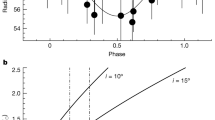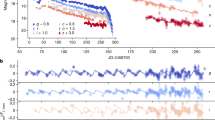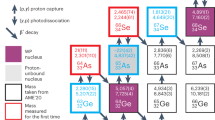Abstract
IN a low-mass X-ray binary (LMXB), mass accreted onto a neutron star from a larger companion generates a flux of X-rays which irradiate the companion. Previous studies of irradiated stars have been restricted to the effects on their outermost layers1–5, or did not address conditions found in interacting binaries6. Here I show that, under the radiative flux typical of a LMXB, the companion will expand towards a new state of thermal equilibrium, and that this expansion provides a new mechanism to drive mass transfer onto the neutron star. The evolution of LMXBs can be drastically altered in this way. In particular, this mechanism may introduce a new evolutionary phase during which the orbital period increases, leading to larger orbital periods during and at the end of mass transfer, and (if the companion is a subgiant) shortening the duration of the LMXB phase. These modifications may help to resolve a number of observational puzzles concerning the numbers and properties of LMXBs and related objects.
This is a preview of subscription content, access via your institution
Access options
Subscribe to this journal
Receive 51 print issues and online access
$199.00 per year
only $3.90 per issue
Buy this article
- Purchase on Springer Link
- Instant access to full article PDF
Prices may be subject to local taxes which are calculated during checkout
Similar content being viewed by others
References
Ruderman, M., Shaham, J., Tavani, M. & Eichler, D. Astrophys. J. 343, 292–312 (1989).
Arons, J. Astrophys. J. 184, 539–550 (1973).
Bath, G. T. Mon. Not. R. astr. Soc. 171, 311–328 (1975).
Osaki, Y. Astr. Astrophys. 144, 369–380 (1985).
Hameury, J. M., King, A. R. & Lasota, J. P. Astr. Astrophys. 162, 71–79 (1986).
Tout, C. A., Eggleton, P. P., Fabian, A. C. & Pringle, J. E. Mon. Not. R. astr. Soc. 238, 427–438 (1989).
Rappaport, S., Verbunt, F. & Joss, P. C. Astrophys. J. 275, 713–731 (1983).
Verbunt, F. & Zwaan, C. Astr. Astrophys. 100, L7–L9 (1981).
van der Klis, M. & Bonnet-Bidaud, J. M. Astr. Astrophys. 214, 203–208 (1989).
Hellier, C., Mason, K. O., Smale, A. P. & Kilkenny, D. Mon. Not. R. astr. Soc. 244, 39p–43p (1990).
Naylor, T., Charles, P. A., Drew, J. E. & Hassall, B. J. Mon. Not. R. astr. Soc. 233, 285–304 (1988).
Long, K. S. & Van Speybroeck, L. P. in Accretion-Driven Stellar X-Ray Sources (ed. Lewin, W. H. G. & Van den Heuvel, E. P. J.) 117–146 (Cambridge University Press, 1983).
Ruderman, M., Shaham, J. & Tavani, M. Astrophys. J. 336, 507–518 (1989).
Djorgovski, S. & Evans, C. R. Astrophys. J. 335, L61–L65 (1988).
Webbink, R. F., Rappaport, S. & Savonije, G. J. Astrophys. J. 270, 678–693 (1983).
Ray, A. & Kluźniak, W. Nature 344, 415–417 (1990).
Patterson, J. Astrophys. J. Suppl. 54, 443–493 (1984).
Author information
Authors and Affiliations
Rights and permissions
About this article
Cite this article
Podsiadlowski, P. Irradiation-driven mass transfer in low-mass X-ray binaries. Nature 350, 136–138 (1991). https://doi.org/10.1038/350136a0
Received:
Accepted:
Issue Date:
DOI: https://doi.org/10.1038/350136a0
This article is cited by
-
Accretion, ablation and propeller evolution in close millisecond pulsar binary systems
Astrophysics and Space Science (2013)
-
The low-mass X-ray binary-millisecond radio pulsar birthrate problem revisited
Science China Physics, Mechanics and Astronomy (2010)
-
Formation and evolution of X-ray binaries
Science China Physics, Mechanics and Astronomy (2010)
-
The two-hour orbit of a binary millisecond X-ray pulsar
Nature (1998)
Comments
By submitting a comment you agree to abide by our Terms and Community Guidelines. If you find something abusive or that does not comply with our terms or guidelines please flag it as inappropriate.



